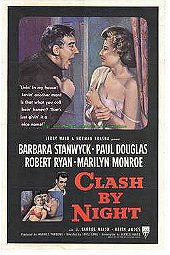A little purple prose-y around the edges, but still infinitely watchable and entertaining thanks to the talents of Barbara Stanwyck in the lead and the supporting roles played by a then up-and-coming Marilyn Monroe and Keith Andes. It’s really two films jammed together and called the same name, each with its own complete dramatic arch.
Stanwyck plays a fallen woman who is returning to her coastal fishing town after a very long absence. She moves back in with her brother (Andes), and his factory worker girlfriend (Monroe), who idealizes and idolizes the imagined big city life that Stanwyck’s character may have led. Stanwyck claims she wants domesticity with Paul Douglas’ good-natured fisherman, but she really wants to re-embrace her inner bad girl with Robert Ryan’s gruff film projectionist. And the first section of the drama ends with Stanwyck choosing a domestic life with Douglas and giving birth to a daughter.
Part two picks up with Stanwyck making Douglas a cuckold, and she’s ready to throw it all away when Douglas disappears with their baby. Now she must chose which of these two men, and their corresponding lifestyles, she will stick with. It shouldn’t come as much of a surprise which one ends up winning out. This is a melodrama from the 50s; all forms of female liberation and sexual agency must be punished and forced back into domestic tranquility, or some semblance thereof.
At times too overripe for its own good, at least Clash by Night can boast of its central performances being uniformly strong. Stanwyck made this kind of role her bread-and-butter, by this time she could do it in her sleep, but she never phones it in for a moment here. And Monroe proves what a capable actress she could be, and could have been, if given more challenging material to work with. Her working class girl is tough, independent, and has big dreams; perhaps it was a little autobiographical for her?
 Login
Login